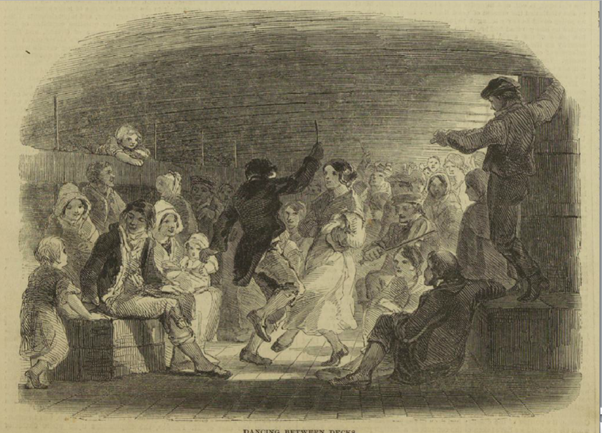Entertainment
11/2/20242 min read


Emigrants dancing between decks, Illustrated London News, 6 July 1850, p.22
Boredom was another of the challenges which the ships’ officers had to manage. The free emigrants on board one of the later convict transports split into two feuding factions over the carving and distribution of a batter pudding at the captain’s table. The surgeon superintendent on that ship warned voyagers to the Antipodes:
'When proceeding out on so long a voyage, a firm resolution should be taken to put up with many little annoyances before venturing to the extremity of a quarrel; as an inconsiderate action or a few hasty words may tend not only to embitter your own quiet of mind, but lead the company generally into angry disputes during the passage.'[i]
Some of the alleged conspiracies on convict ships were probably just bored men exercising their imaginations, but there were also inveterate troublemakers who delighted in turning convicts and supervisors against one another. There were also those who enjoyed bullying weaker men.
And of course, there was a problem with theft. It was principally a case of prisoners stealing from one another, but they would also pilfer the government stores and ship provisions if given half a chance. The property was rarely recovered, the culprits going unpunished because the other prisoners were reluctant to inform on their peers.
Others found productive ways of keeping themselves busy. From the First Fleet onwards, convicts with seacraft were permitted to work on deck alongside the crew in relatively large numbers, and men with trade skills – carpenters and joiners, ropemakers and sailmakers – could make reasonable money working for the master. Prisoners manufactured items of clothing, did washing and mending, cut hair, wrote up the ship’s accounts and journals, made drawings and sold sexual services. On some ships, the masters employed the convicts to make up articles for later sale in the colony, paying them with rum, tea and tobacco, clothing and provisions, and in some cases, cash.
They organised games and dances on the upper deck, sang songs and staged concerts, plays and mock trials. Following the appointment of surgeon superintendents in 1815, schools were organised to teach men and boys to read and write, and from 1820, the Newgate Ladies Committee, established by the prison reformer, Elizabeth Fry, sent straw for the women to weave hats and bonnets, as well as haberdashery and scissors.
Gambling was forbidden, although there appears to have been a great deal of cards and dice, pitch and toss. One of the earliest references to the iconic Australian game of two-up is found in the journal of a surgeon superintendent who gave a boy two dozen lashes, ‘having been detected. . . in the act of tossing up coppers and calling out &c.’[ii] (See published article on Two Up)
____________
[i] Peter Cunningham, Two Years in New South Wales, London: Henry Colburn, 1827, Vol.1, pp.19-20.
[ii] Journal of James Dickson, Surgeon Superintendent of the Countess of Harcourt, (1824), UK National Archives, ADM101/18/3, 1 May 1824.
Contact us
Connect with us
Botany Baymen acknowledges the traditional custodians of country throughout Australia and respects their connection to land, water and community.
© Botany Baymen 2024. All rights reserved.
You may download, display, print and reproduce this content for your personal or non-commercial use but only in an unaltered form and with the copyright acknowledged.

